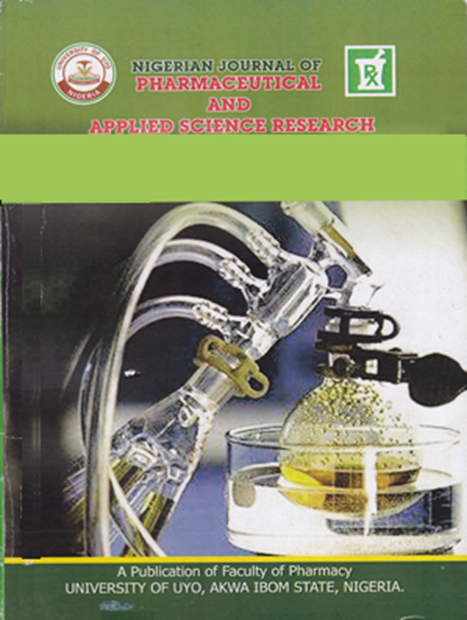Phytopharmacognostic investigation of Microdesmis puberula HOOK F. EX. PLANCH (PANDACEAE)
Main Article Content
Abstract
Background: The stem bark, root and leaf of Microdesmis puberula Hook. F. ex. Planch (Pandaceae) is used to treat stomach ache, burns, circumcision wounds, abscesses and sores from gonorrhea. This study aimed at evaluating the pharmacognostic features of the leaf and stem of M. puberula using quality control parameters. Leaves and stems were collected, air-dried, pulverized and stored in a clean glass container.
Methods: Methods used were microscopy, micromeritic properties, chemomicroscopy, moisture content, ash values, extractive values and fluorescence analysis using standard procedures.
Results: Microscopic features as irregular epidermal cell shape and undulate anticlinal wall pattern were recorded on both surfaces. Hypostomatic distribution of stomata with anomocytic and anisocytic stomata as well as stomatal index of 15.1 % on the abaxial surface were recorded. The stem powder had a better flow rate than the leaf powder. Chemomicroscopy revealed the presence of cellulose, mucilage, oil and starch grain in both leaf and stem. Moisture contents, total ash values, acid-insoluble ash values and water-soluble ash values for the leaf and stem were (89.3 and 87.6 % w/w), (5.41 and 2.41 % w/w), (1.92 ± 0.00 % w/w) , (0.83 ± 0.00 % w/w ), (1.17 ± 0.00% w/w) and (0.42 ± 0.00 % w/w ) respectively. Water had the highest solubility (3.75 %) of the leaf constituent in water.
Conclusion: These findings offer a foundational pharmacognostic profile for M. puberula, supporting its traditional uses and enabling future quality control, medicinal standardization, identification and authentication.
Downloads
Article Details

This work is licensed under a Creative Commons Attribution-NonCommercial-NoDerivatives 4.0 International License.
References
Zamble A, Yao D, Martin- Nizard F, Saphez S, Offoumou M, Duriez P, Brunet C, Bailleul F. Vasoactivity and antioxidant properties of M. keayana roots .Journal of Ethnopharmacology, 2006: 104: 263- 269.
Neuwinger HD. African traditional Medicines: a dictionary of plant use and applications. Medpharm scientific, Stuttgart, Germany.2007. 589 p.
Angiosperm Phylogeny Group (APG). An update of the angiosperm phylogeny group classification for the order and families of flowering plant APG IV. Botanical Journal of the plant Linnaean Society, 2016: 181(1): 1-20.
Essiett UA, Archibong IA. The taxonomic significance of certain anatomical variation in four genera of Asteraceae. Bulletin of Environment, Pharmacology and Life Sciences, 2014: 3 (5): 150-163.
Abubakar BY, Yunusa AI. Epidermal structure and stomatal ontogeny as an aid to the taxonomic identification of some species of Acacia from Nigeria .Nigerian Journal of Botany, 1998: 2: 117-123.
Mbah C C, Builders PF, Akuodor GC, Kunle OO. Pharmaceutical characterization of Bridelia ferruginea Benth (Euphorbiaceae). Tropical Journal of Pharmaceutical Research, 2012: 11 (4): 637-644.
Kokoski CJ, Kokoski RJ, Slama FJ. Fluorescence of powdered vegetable drugs with particular reference to development of ultraviolet light radiation.Journal of the American Pharmaceutical Association, 1958: 38: 715-719.
Kokate CK, Purohit AP, Gokhale SB. Pharmacognosy. Nairali Prakashan, 4th edition. 2003: 109 (119): 121 -123.
African Pharmacopoeia. General Method of Analysis. OAU/STRC Scientific Publication, Lagos, 1986: 3(1): 128-142.
Khandelwal KR. Practical pharmacognosy techniqes and experiments. New Delhi, Nirali Prakashan, 2002: 15-163.
WHO. Quality control methods for medicinal plant materials. World Health Organization. Geneva. 1992.
Evans WC. Trease and Evans Pharmacognosy 115th edition. Elsevier, 2005. 20 p.
Gupta MM, Srivastava B, Sharma M, Arya V. Spherical crystallization: A tool of particle engineering for making drug powder suitable for direct compression. International Journal of Pharmaceutical Research and Development, 2010: 1:1-10.
Walter I. The Pharmaceutical Codex, principles and Pharmaceutics, 2009: 12:184-185.
Marinelli, J. (2013). Factors that impact a powder flowability. https://www.powder bulksolids.com.
Abere TA, Onwukaeme ND. Pharmacognostic evaluation of the leaf of Secamone afzelii (Schult) K. Schum. (Asclepiadaceae). Tropical Journal of Pharmaceutical Research, 2012: 11(1): 125-131.
European Pharmacopoeia. Pharmacopoeia Limits of Crude drugs. Strasbourg: Council of Europe, 2007: 6: 124-164.
Tatiya A, Surana S, Bhavsar S, Patil D, Patil Y. Pharmacognostic and preliminary phytochemical investigation of Eulophia herbaceae Lindl. Tubers (Orchidaceae). Asian Pacific Journal of Tropical Diseases, 2012: 2(1): S50-55.
Ozarkar KR. Studies on anti-inflammatory effects of two herbs Cissus Quadrangularis Linn. and Valeriana wallichi DC using mouse model. Ph.D. Thesis, University of Mumbai, Mumbai. 2005.
Shwetajain SC, Khatri P, Jain A, Vaidya A. Pharmacognostic and phytochemical investigations of the leaves of Zizyphus xylopyrus (Retz) Willd. International Journal of Pharmacy and Pharmaceutical Sciences, 2011: 3: 122-125.
Kripa KG, Sangeetha R, Chamundeewari D. Pharmacognostical and physicochemical evaluation of the plant Leucas aspera. Asian Journal of Pharmaceutical and Clinical Research, 2016: 9: 263-268.
Kam PC, Lie S. Traditional Chinese herbal medicine and anaesthesia. Anaesthesia, 2002: 57 (11): 1083-1089.
Ali SS, Kasoju LA, Singh A, Sharanabasava H, Sahuand A. Indian medicinal herbs as a source of antioxidants. Food Research International, 2008: 41: 1-15.
Alagar RM, Shailaja V, David B, Rao KNV, Selva-Kumar D. Evaluation of standardization parameters, pharmacognostic study, preliminary phytochemical screening and in vitro antidiabetic activity of Emblica officinalis fruits as per WHO guidelines. Journal of Pharmacognosy and Phytochemistry, 2014: 3(4):21-28.
Umoh RA, Johnny II, Udoh AE, Andy NA, Essien A, Udoh IJ, Ekpo TE, Ashibeshi GU. Taxanomic and Pharmacognostic Evaluation of Leaf of Mussaenda phillippica (Rubiaceae). Asian Plant Research Journal, 2022: 9(1):6-13.
Umoh RA, Umoh UF, Johnny II, Umoh OT, Anah VU, Udoh AE, Elijah AA, Adefabi MA, Matthew EA. Phytopharmacognostic Evaluation of the Leaves of Gnetum africanum Welw (Gnetaceae). Journal of Complementary and Alternative Medical Research, 2020: 11(3):32-41.
Umoh RA, Johnny II, Umoh OT, Udoh AE, Anah VU, Obah-Eni LC. Pharmacognostic Evaluation of the Leaves and Stems of Justicia secunda Vahl. (Acanthaceae). World Journal of Pharmaceutical Research, 2020: 9(11):5-18.


